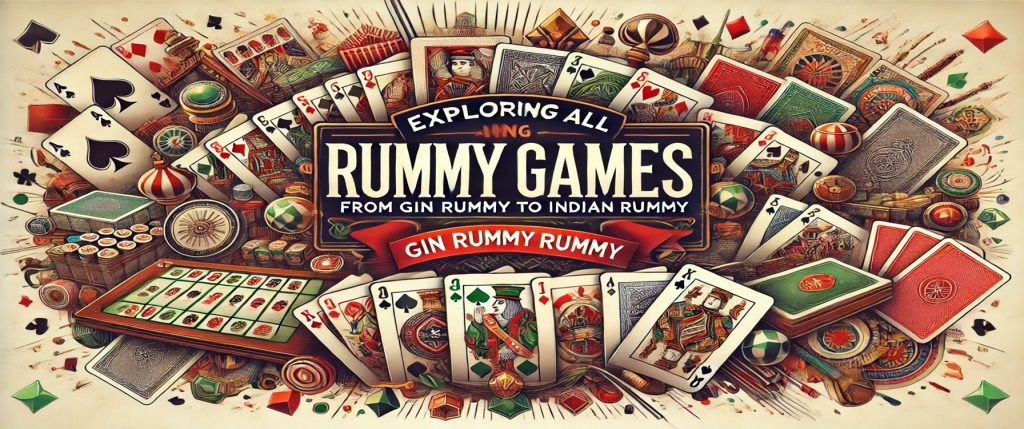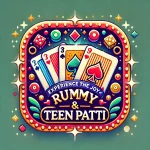Description

The Definitive Handbook of Rummy Games The history of rummy games is extensive and diverse, spanning centuries and continents. Rummy’s beginnings date back to the early 1800s, and many historians believe it developed from a game called “Concentration” or “Rum,” which was played in the US. The game’s rapid rise in popularity prompted the creation of numerous variations and forms.
Rummy arrived in Europe in the late 1800s and experienced additional changes there. Different cultures adopted the game and gave it their own twist, adding to the variety of rummy games that exist today. Rummy became a common feature of social events and family game nights as it expanded throughout the world. Players of all ages can enjoy the game because it allows for a balance between skill and chance.
Rummy started to become commercialized in the early 1900s when standardized decks & rulebooks were introduced. Popular variations like Gin Rummy and Indian Rummy, each with its own set of rules and strategies, also emerged during this time. The growth of leisure activities & the growing significance of social interaction in gaming are two examples of broader social changes that are reflected in the evolution of rummy. These days, rummy is more than just a game; it’s a cultural phenomenon that keeps changing with the times. Overview of the Gameplay. A draw pile is created from the ten cards dealt to each player.
In order to form legitimate combinations, players alternately draw from the draw pile or the discard pile. Three or four cards of the same rank make up a set, whereas three or more cards of the same suit in a row make up a run. Getting the win.
One player “knocks,” signifying that they have made legitimate card combinations, to end the game. A further layer of strategy is introduced into Gin Rummy by the scoring system. Upon knocking, a player displays their melds and determines the sum of their unmatched cards.
Both strategy and scoring. The knocker’s total is then reduced by the opponent’s unmatched card values after they have revealed their melds. The opponent scores points if the knocker’s total is greater than theirs; otherwise, they score points based on the difference.
This scoring system incentivizes players to monitor their opponent’s possible combinations in addition to concentrating on creating their own melds. For generations, players have been enthralled with Gin Rummy because of its captivating combination of skill, strategy, and luck. In India & among Indian communities around the world, Indian Rummy is a well-liked variation of the game. Two to six players can participate, and two decks of cards are usually used.
Utilizing the cards dealt to each player, the main goal is to create legitimate sets and sequences. Three or more cards of the same suit in a row make up a valid sequence, whereas three or four cards of the same rank but different suits make up a set. After each player receives 13 cards, the remaining cards are arranged in a draw pile, with one card being discarded face-up. Like other rummy variations, Indian Rummy is played by drawing and discarding cards in turns. One distinctive feature, though, is that players have to create a minimum of two sequences, one of which needs to be pure (i.e., devoid of a joker).
Because they can be used as wild cards to replace any other card in sets or sequences, jokers are important in Indian Rummy. A player reveals their melds for scoring when they declare that they have used all of their cards to form valid combinations, ending the game. Indian Rummy is a thrilling challenge for players because it requires strategic depth in managing one’s hand while predicting the moves of opponents. Numerous variations of rummy exist, each with its own distinct set of rules & strategies for play.
Other well-liked variations of rummy besides Gin Rummy and Indian Rummy are Pinochle Rummy, Canasta, & Kalooki. Kalooki, which is frequently played with two decks, places a strong emphasis on making melds fast and strategically handling discards. On the other hand, Canasta adds a collaborative element to the game by requiring players to form melds of seven cards or more in two partnerships using four players. Pinochle Rummy, which blends aspects of the card games Pinochle and Rummy, is another noteworthy variant. In this variation, players attempt to win tricks based on card values while simultaneously attempting to form melds.
To accommodate players’ varying tastes, each variation presents unique obstacles and tactics. Whether you like more strategic gameplay or fast-paced action, there is something for everyone in the variety of rummy games. Rummy’s enduring appeal across cultures and generations can be attributed in part to its adaptability. A combination of deft play, strategic thinking, and astute observation are necessary for winning at rummy. One essential tactic is to closely observe the cards that opponents discard.
Players can learn more about their opponents’ hands and modify their tactics by keeping track of which cards are picked up or discarded. An opponent may be on the verge of creating a winning hand if, for example, they routinely discard high-value cards. If an opponent declares first, on the other hand, keeping low-value cards can help reduce the number of points. Effective hand management is another powerful tactic.
Aiming to create melds as fast as they can, players should leave their options open for subsequent turns. Keeping adaptable cards that can contribute to several possible melds is frequently preferable to making hasty commitments to particular combinations. Jokers can also be used strategically to disrupt your opponent’s plans or fill gaps in your hand, which can greatly increase your chances of winning. In the end, playing rummy successfully requires striking a balance between defense—keeping opponents from finishing their melds—and offense—forming your own. Rummy games are now a popular past time all over the world, spanning both cultural & geographic divides.
For example, Indian Rummy has gained widespread popularity in both informal and competitive settings in India, demonstrating its profound cultural significance. Participant social ties are strengthened by the game, which is frequently played at festivals and family get-togethers. In a similar vein, Gin Rummy has remained a beloved card game in Western nations like the US and Canada, where both friends and family play it. The popularity of rummy games has increased worldwide due to the growth of online gaming platforms.
It is now possible for players to play against opponents from other nations without ever leaving their homes. This ease of access has resulted in a rise in rummy fans who take part in online leagues and tournaments, fostering thriving communities around this classic game. Rummy games’ popularity and reach grow along with technology, guaranteeing their continued relevance in a constantly shifting gaming environment. Playing rummy has long been linked to fostering community and social interaction. Rummy is a conversation starter and a way to foster friendships, whether it is played at parties or with family.
New players can easily join in without feeling overwhelmed thanks to the game’s comparatively simple rules, which promote an inclusive environment where players of all skill levels can participate. Because of its accessibility, relationships are strengthened through shared experiences, friendly competition, & laughter. Also, because of its versatility, rummy can be played in a wide range of social settings, from informal get-togethers to more formal events like weddings or business gatherings. Rummy is a popular game for people who want to relax after a long day or break the ice in new situations. Players make enduring memories that transcend winning or losing as they use strategic thinking & lighthearted card-playing.
Rummy thus becomes a tool for connection that enhances social interactions rather than just being a form of entertainment. The introduction of online gaming has completely changed the way that people play rummy and given rise to a thriving international online community. By removing geographical restrictions that previously restricted participation in this popular card game, online platforms allow players to compete against others whenever they want.
By simply clicking to join tournaments or casual matches, players can meet rummy enthusiasts from a variety of backgrounds who share their enthusiasm. Online rummy platforms often include forums and chat rooms where players can exchange strategies, advice, and friendships outside of the virtual table in addition to making gameplay easier. For players who might not have access to nearby rummy clubs or groups, these communities help them feel like they belong. In addition, a lot of online platforms regularly hold tournaments & events that improve participation & give players a chance to show off their abilities on bigger stages.
In order to ensure that this timeless game is played by future generations, the online rummy gaming community is expected to become even more vibrant and connected as technology develops. To sum up, rummy games have changed a lot over time while still being popular social games that encourage players to think strategically & bond with one another. Due to its many variations and deep cultural significance, rummy has captured the attention of audiences all over the world, from its historical origins to contemporary online communities.


